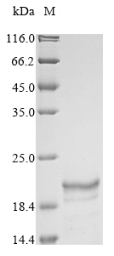Recombinant Sudan ebolavirus Envelope glycoprotein (GP) is produced in E. coli, covering amino acid region 502-637. This partial protein carries an N-terminal 6xHis-KSI tag to help with purification and achieves over 85% purity as confirmed by SDS-PAGE. The preparation appears suitable for various research applications and should provide reliable, reproducible results.
The Sudan ebolavirus Envelope glycoprotein (GP) likely plays a crucial role in the viral lifecycle, particularly in mediating entry into host cells. It seems essential for fusion of the viral membrane with the host cell membrane, which makes it a significant focus in virology research. Understanding its structure and interactions may be vital for developing therapeutic approaches against ebolavirus infections.
Potential Applications
Note: The applications listed below are based on what we know about this protein's biological functions, published research, and experience from experts in the field. However, we haven't fully tested all of these applications ourselves yet. We'd recommend running some preliminary tests first to make sure they work for your specific research goals.
This recombinant protein represents only a very short fragment (136 amino acids, 502-637aa) of the full Sudan ebolavirus GP protein. As a small, non-glycosylated peptide expressed in E. coli, it completely lacks the essential structural features required for GP functionality - including trimerization, complex glycosylation, and the complete receptor-binding domain. While it may be soluble, this fragment is fundamentally incapable of mimicking the structural or functional properties of the native viral glycoprotein.
1. Antibody Development and Epitope Mapping
This application is highly suitable as it relies solely on linear epitope availability. The fragment can generate antibodies specific to the 502-637aa region, though these antibodies may not recognize conformational epitopes on the native, fully glycosylated GP protein.
2. ELISA-Based Binding Assays
This application is suitable for detecting antibodies against linear epitopes. The fragment can serve as a coating antigen for qualitative detection assays targeting the 502-637aa region.
3. Biochemical Characterization and Stability Studies
Basic biophysical characterization can be performed, but results will only reflect this short peptide's properties, not the native GP protein's behavior.
Final Recommendation & Action Plan
This short GP fragment (502-637aa) is essentially a linear peptide that cannot replicate any structural or functional aspects of the native ebolavirus glycoprotein. It is suitable only for Applications 1 and limited aspects of Applications 2 and 3 - specifically for linear epitope antibody production and basic peptide characterization. The short, non-native fragment lacks proper folding context and may expose non-physiological surfaces, leading to extensive non-specific binding or failure to replicate genuine GP interactions. For authentic GP research, full-length, properly glycosylated protein produced in mammalian or insect cells is essential.






